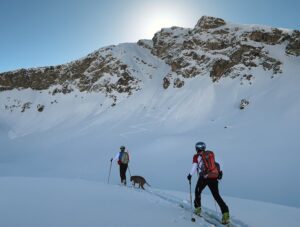When Pakistan reopened to climbers last fall, a handful of small teams immediately headed for unclimbed peaks and rarely visited corners. Among them were Sophie Lenaerts, Stef Maginelle and Jean-Francois Spelmans (aka Jeff). They went to Hispar-Biafo to ski and hopefully to climb Lukpe Lawo Brakk (6,593m) but mainly to explore.
Bad weather foiled their attempt on Lukpe Lawo Brakk, but they still returned home elated to have spent weeks in a place where “lockdown” meant only locking down your skis. Here, Sophie Lenaerts discusses one of the exploratory climbs they did during the trip.

Whiteout conditions on the glacier.
The threesome used skis and sleds to cross the glacier toward Lukpe Lawo Brakk in total solitude. They covered the first part in 50cm of fresh snow and poor visibility. “Metre after metre we struggled to advance,” Lenaerts recalled. “When Jeff had to right his overturned sled for the umpteenth time, we tried to find a system to go faster.”
Spelsmans eventually broke trail without a sled. Lenaerts followed with one sled to further tamp down the way, then Maginelle brought up the rear, towing two sleds. Their one-kilometre-an-hour pace made them wonder if they’d ever get to the peak, considering that it was 35km away.

Approaching an unnamed peak as the sky clears.
“An elegant couloir slowly appeared on our right side, on the southern flank of an unknown mountain,” said Lenaerts. They quickly decided to climb that intriguing Y-shaped couloir, split on top by a giant fin of rock. They approached roped up, because of the risk of hidden crevasses.
“This route is on the south flank and can probably only be climbed in winter and under certain conditions,” she said.
The climb featured an easy gradient of 45 to 50 degrees. Eventually, there was less snow, and progress over the mostly bare rocks became slower. The couloir also turned out to be longer than they had expected. “At the split (4,890m), we decided to take the right side with the hope of being able to follow it to a summit,” said Lenaerts.

Up the couloir on a perfect day.
They eventually reached the top, at an altitude of more than 5,170m. They had already climbed more than 1,000m above their tent. On their descent, just below the ridge, they came to the most dangerous part. “There is no way to secure [an anchor], and the snow reached to the hips,” she said.
The warm weather in the sheltered couloir also made them concerned about avalanches, but they managed to descend safely and reached camp after dark, by headlamp.
“The days are short in winter, but we considered ourselves lucky to have this unexpected gift on a beautiful day,” said Lenaerts. “We found what we came for: Climbing to discover, exploring nature, forming close friendships.”
They will be returning to Pakistan in the summer to attempt Broad Peak.

Their line up what they called the Yaari couloir, after the Urdu word for friendship.






